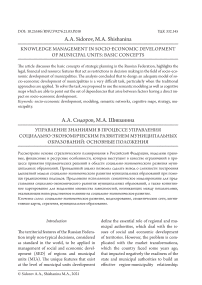Knowledge management in socio-economic development of municipal units: basic concepts
Автор: Sidorov A.A., Shishanina M.A.
Журнал: Вестник Российского нового университета. Серия: Человек и общество @vestnik-rosnou-human-and-society
Рубрика: Экономические науки
Статья в выпуске: 3, 2021 года.
Бесплатный доступ
The article discusses the basic concepts of strategic planning in the Russian Federation, highlights the legal, financial and resource features that act as restrictions in decision making in the field of socio-economic development of municipalities. The analysis concluded that to design an adequate model of socio-economic development of municipalities is a very difficult task, particularly when the traditional approaches are applied. To solve the task, we proposed to use the semantic modeling as well as cognitive maps which are able to point out the set of dependencies that arise between factors having a direct impact on socio-economic development.
Socio-economic development, modeling, semantic networks, cognitive maps, strategy, municipality
Короткий адрес: https://sciup.org/148321644
IDR: 148321644 | УДК: 332.145 | DOI: 10.25586/RNU.V9276.21.03.P.018
Текст научной статьи Knowledge management in socio-economic development of municipal units: basic concepts
The territorial features of the Russian Federation imply non-typical decisions, considered as standard in the world, to be applied in management of social and economic development (SED) of regions and municipal units (MUs). The unique features that exist at the level of municipal units development define the essential role of regional and municipal authorities, which deal with the issues of social and economic development of territories. However, the problem is complicated with the market transformations, which the country faced some years ago, that impacted negatively the readiness of the state and municipal authorities to build an effective region-municipality relationship.
Knowledge Management in Socio-Economic Development of Municipal Units...
Сидоров Анатолий Анатольевич кандидат экономических наук, доцент, заведующий кафедрой автоматизации обработки информации (АОИ) Томского государственного университета систем управления и радиоэлектроники. Сфера научных интересов: принятие решений, социально-экономическое развитие, государственное и муниципальное управление, информационно-аналитическое обеспечение управления, цифровизация управления. Автор 60 опубликованных научных работ.
This fact is explained by regulatory and legal features, funding and the lack of a comprehensive system able to provide information and analytical support that allows predicting the territorial development. In this regard, the scientific rationale for decision-making in the field of SED of MU is relevant regardless of the development level that the territories have, so the purpose of this work is to describe the approach enabling to improve the effectiveness of management decisions in the planning, forecasting and programming in SED of MU. The main contribution of the work is presented by a semantic network describing the basic concepts and relationships in management used in SED of MUs, which is characterized by the factors that define the SED in a residential place. These factors allow to identify the standard MUs within the region (of the country), for which the specific territory development strategies (models) can be used. As the addition to the semantic model there is used a cognitive map allowing to consider the interdependences among indicators applied in assessing SED of MUs.
Special Management Features for Social-Development of Municipal Units
At the basis of SED for the regions and MUs in accordance with the current legislation (Federal law dated on 28 June 2014 No. 172-FL “about the strategic planning in the Russian Federation”) there is the strategic management, which is represented in the basic guiding documents – long-term and intermediate-term programs – aimed at the global development in changing environment [9]. Thus, management in SED of MUs – is a constant process aimed at developing, making and applying the managerial decisions including the situation monitoring measures, approaches to the strategy development as well as implementing plans and programs efficacy evaluation. The analysis of normative-legal documents showed the general view of strategic management that includes the following stages:
-
• strategic analyses;
-
• strategic synthesis;
-
• goal-setting;
-
• project-based activities;
Экономика и территориальное управление
-
• strategy mechanisms searching;
-
• results assessment.
As a result, SED management can be presented as a model (fugure 1), where the key role in planning belongs to the statebased authority, since the first-priority purposes of the federal level (shown with the arrows in figure 1) are projected initially for the larger territorial entities (federal regions), the Russian Federation subjects and only then “go down” to the MUs level.
Ideally, the municipal strategic governance as the basis should have strategic plans for local authorities, taking into account the public opinion and the opinion of the business community. However, in practice the situation is different. The local authorities make attempts to implement a strategy based on existing administrative methods. This results in actions only from the part of an executive body, excluding the levels of the local community, business, and etc. Additionally, the staff shortage in MUs impacts negatively, since the existing staff do not have sufficient knowledge in strategic and project management; therefore the changes happening in the external and internal environment aggravate the SED strategy implementation. As a result, the following key challenges in strategic planning at the MUs level can be pointed out [7, 8]:
-
• non-systemic organization of strategic development;
-
• administrative management methods domination;
-
• insufficient methodological support from the regional authorities for local initiatives;
-
• knowledge gap in strategic and project management among officials of different levels (especially in MUs);
-
• strict financial dependence, since MUs, as a rule, are deprived of additional financial sources;
-
• lack of an effective mechanism for interaction between local government bodies with the local community, business companies and others parties interested in development.
On the assumption that the strategic planning system at the level of MUs requires rethinking but it is practically impossible to implement at the level of the municipality, excluding the federal level, there is an objective need to increase the level of scientific and methodological substantiation of managerial decisions taken by authorities and administrations in planning and forecasting as well as assessing the effectiveness of socio-economic development of the territory. As a result, the SED management model (“top-down”) is transformed into a “bottom-up” model
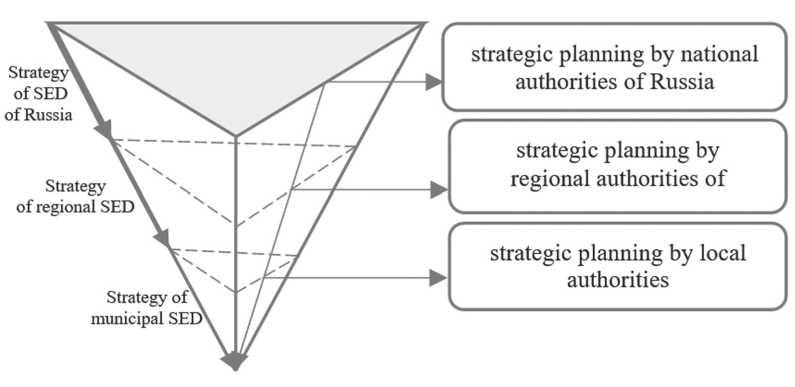
Knowledge Management in Socio-Economic Development of Municipal Units...
(fugure 2), which will take into account the specifics of the territories when planning long-term development aimed at the national strategic goals.
Despite the fact that the model presented in fugure 1 is conceptually different from the model depicted in fugure 2, it can be implemented under current conditions with regulatory, financial, labor and other restrictions. Management of the SED targeted at the territories (especially at MUs) is a nontrivial task, the solution of which requires, inter alia, a creative approach. However, on the part of the legislator, this process is regulated (a list of mandatory documents has been developed, various methods to analyze situations are recommended, etc.), which can actually reduce all creative work to templates use. Still, it is impractical to use one template for all MUs in the Russian Federation (or in a specific region), because each territory is unique and has its own development features. Except that, it can be assumed that throughout the territory of the Russian Federation there are the MUs with similar levels and vectors in development (for example, climatic conditions, population size, the major industry field, etc.).
As a result, such MUs will act as the standard models, on the basis of which the template-based strategies can be developed. This approach will allow to a certain extent to standardize planning and managiement processes in SED. As a result, the existing SED system will be based not only on the regional goals, but also on the municipal initiatives, which will vary against the types of territories. Thus, in order to achieve the state goals and increase the effectiveness territories’ management at all levels, it is necessary to take into account the peculiarities of MUs development and present the management of SED in a comprehensive manner as a semi-structured system.
Application of Semantic and Cognitive Tools in SED Management of MUs
The analysis evaluating SED of MUs showed that the management model is multilevel. At the same time, it is noted in [6] that semantic models are most suitable for modeling SED, since these models allow using a visual representation close to a natural language. Based on the data shown in Fugure 3 that represents the semantic network in general viewit should be noted that the strategy of SED of
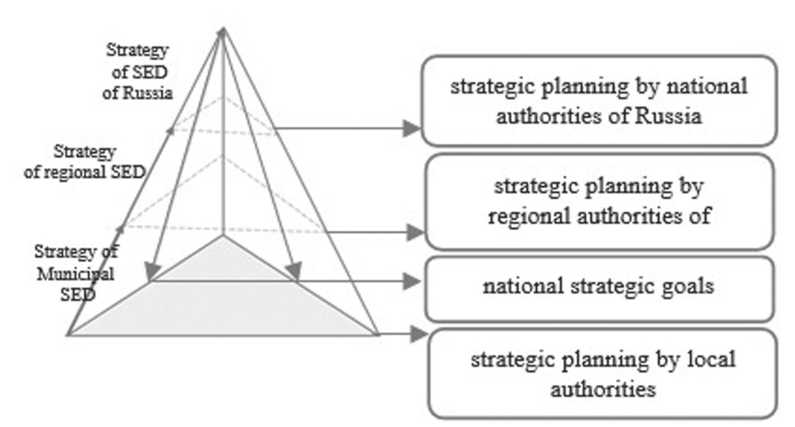
Экономика и территориальное управление
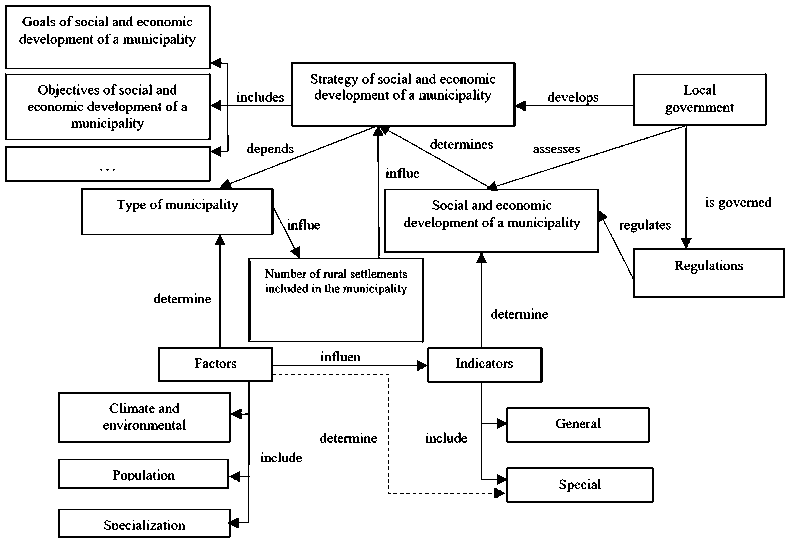
Figure 3. Semantic network of SED management of MUs
MUs depends on the type of MU, its current level of SED, as well as on the number of residential places under the responsibility of a MU.
Analysis of research with a focus on SED shows that any model are attributed with geographical and legal characteristics corresponding to the development of the Russian Federation. Based on this conclusion, the type of a municipality is described by a number of factors that can be formally represented as a set
The current level of SED in MUs is assessed with a number of indicators. Figure 3 shows that it is reasonable to conduct the assessment on general indicators applicable to all municipality types (e.g. demographics) and on special indicators, the combination of which will depend on the specific municipality type (e. g. indicators that reflect the predominant development of forestry or agriculture).
The set of assessment indicators characterizing the SED level in MUs are interdependent (e.g. demographics influence indicators describing the development of social infrastructure and etc.), which should be taken into account when the SED model of MUs is being developed. However, the semantic network does not allow to determine how connections between indicators are strong, which means that this type of relations can be described through cognitive modeling tools.
As noted in [3, 4, 10], cognitive modeling of semistructured systems is one of the dimensions of the modern theory of decision support that allow to achieve some adequate results with a large number of interdependent
Knowledge Management in Socio-Economic Development of Municipal Units...
factors. The cognitive modeling has several stages, among which the main one is the identification stage that points out a set of factors and the relationship between them in the semistructured system. The regulatory documents analysis showed that many indicators used for assessing SED model of MUs will act as restrictions to the subject field. Summarizing this set of SED MUs indicators, presented in the strategic documents, the general indicators were identified, on the basis of which a typical cognitive model was designed (fugure 4), which can serve as the basis for modeling SED management on particular territories.
Based on this model, a conclusion can be made that the quality of life should be used as the target factor, since federal-level stra- tegic documents identify it as a key factor in municipal SED. “Production” can be used as a variable (special) factor, because it will be showing significant variation depending on the specialization of any given territory (e.g. settlements can be specialized in agriculture, mining, and so on). Each of the factors can be broken down, revealing new levels, links and relationships within the model.
In turn, analysis of various types of cognitive maps [1, 2, 5] (Table) shows that their tool set is quite adaptive. However, according to the indicated criteria, the Silov’s fuzzy cognitive maps are most suitable, since when designing them, it is possible to denote a negative connection and evaluate its impact. It is especially important when considering the SED indicators
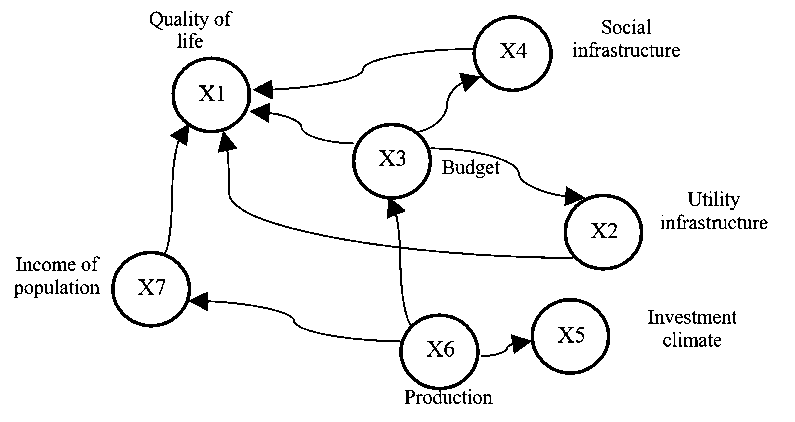
Figure 4. Standard cognitive model of SED
Comparative analysis of types of cognitive maps
|
Criterion |
Conventional symbolic cognitive maps |
Kosko’s fuzzy cognitive map |
Silov’s fuzzy cognitive map |
Fuzzy relational cognitive map |
|
Option to set the strength of connection |
– |
+ |
+ |
+ |
|
Option to set the negative strength on connection |
+ |
– |
+ |
– |
|
Usability in problems with quantitative and qualitative factors |
– |
+ |
+ |
+ |
Экономика и территориальное управление
(for example, crime indicators will have a negative impact on the life quality indicators). Also the fuzzy cognitive maps of Silov have proven themselves well to design the semi-structured systems, which include SED of MUs [1].
In this regard, the fuzzy cognitive map can be represented as follows: G = <Х, W>, where Х = {х 1, х2, ... , хn} corresponds to a set of concepts (factors) in the subject area (in this case, a set of indicators for evaluation of municipal SED), and W is relations over the set E that determine the combination of connections between elements of the given set. Elements ei and ej are considered connected by the following relation w(ei, e,) e W ^ [-1, 1] if any change in the value of factor ei (cause) results in a change in the value of factor ej (effect). Thus, ei is deemed to have an effect on ej.
The general calculation rule for the values of concepts of Fuzzy Cognitive Map has been proposed [11]:
(
n
) t - 1
/
At = f ki £ A' Wj + k2 Ai j=1
V j * i
Ait – is the value of concept Xi at time t, Atj-1 – the value of concept Xj at time t – 1, Ait-1 – is the value of concept Xi at time t, and the weight Wij – of the interconnection from concept Xj to concept Xi, f is a threshold function which squashes the result in the desired interval. The coefficients k1 and k2 can take different values according to any specific case and are determined by the expert. As a result, the cognitive map allows solving two types of tasks: static (current situation analysis, including the study of effects that some indicators relate to others, the study of situation stability as a whole and the search for structural changes to get the stable structures) and dynamic (generation and analysis of some possible scenarios for evolving situation at different time/over time).
Conclusions
The SED of the territory is a complex and continuous process of planning and forecasting, which the authority bodies of all levels have to deal with. However, despite the formalized approach to planning at the federal level, municipalities in their activities face a number of challenges. The main difficulties in the decisionmaking process in the field of SED conclude in the lack of complete information about the territory development from a person who makes decisions. This is due to the fact that SED is the semi-structured subject field and this fact must be taken into account when planning and forecasting are under way. To neutralize the negative impact from the problems, which have been identified in the research, it is proposed to use in management practice the semantic-cognitive tools that will allow to increase the quality and the validity level of managerial decisions made by officials. The proposed approach to formalizing a semi-structured area of public relations can be used as the basis to design the decision-support systems both in municipalities and in other territorial units. This paper is designed as part of the state assignment of the Ministry of Science and Higher Education; project FEWM-2020-0036.
Список литературы Knowledge management in socio-economic development of municipal units: basic concepts
- Силов В.Б. Принятие стратегических решений в нечеткой обстановке. М.: ИНПРО-РЕС, 1995. 228 с. = Silov V.B. (1995) Prinyatie strategicheskikh reshenij v nechetkoj obstanovke [Making Strategic Decisions in a Fuzzy Environment]. Moscow, INPRO-RES Publishing. 228 p. (In Russian).
- Aguilar J. (2004) A Dynamic Fuzzy-Cognitive-Map Approach Based on Random Neural Networks. International Journal of Computational Cognition, vol. 1, pp. 92–107.
- Axelrod R. (1976) Structure of Decision: the Cognitive Maps of Political Elites. Prinston University Press. 395 p.
- Gray S.A., Zanre E., Gray S.R.J. (2014) Fuzzy Cognitive Maps as Representations of Mental Models and Group Beliefs. In: Fuzzy Cognitive Maps for Applied Sciences and Engineering – From Fundamentals to Extensions and Learning Algorithms, pp. 29–48. DOI: 10.1007/978-3-642-39739-4_2
- Kosko B. (1986) Fuzzy Cognitive Maps. International Journal of Man-Machine Studies, vol. 1, pp. 65–75.
- Nikitenko S.M., Goosen E.V. (2017) Socio-Economic Development of Territories Based on the Principles of Public-Private Partnership in the Sphere of Comprehensive Mineral Exploration. IOP Conference Series: Earth and Environmental Science, vol. 84, pp. 1–5. DOI: 10.1088/1755-1315/84/1/012013
- Senchenko P.V., Sidorov A.A., Ekhlakov Y.P. (2017) Information and Analytical Support of Management Activities. 11th IEEE International Conference on Application of Information and Communication Technologies, AICT 2017 – Proceedings.
- Senchenko P.V., Sidorov A.A. (2018) Formal Models of Monitoring of Dispersed Socio-Economic Objects. 12th IEEE nternational Conference on Application of Information and Communication Technologies, AICT 2018 – Proceedings.
- Senchenko P.V., Sidorov A.A. (2020) Software in the Field of Information and Analytical Support for Territorial Management: a Methodological Approach to Assessment. Journal of Physics: Conference Series, vol. 1488, pp. 1–6.
- Senchenko P.V., Zhukovskiy O.I., Gritsenko Y.B. (2016) The Web-Based Information System for Small and Medium Enterprises of Tomsk Region. Journal of Physics: Conf. Series, vol. 803, pp. 1–8.
- Stylios C., Groumpos P. (2000) Fuzzy Cognitive Maps in Modeling Supervisory Control Systems. Journal of Intelligent & Fuzzy Systems, vol. 8, no. 2, pp. 83–98.

